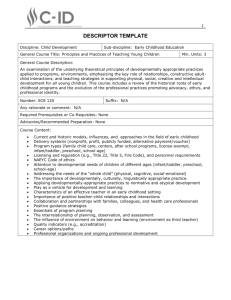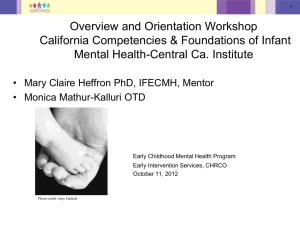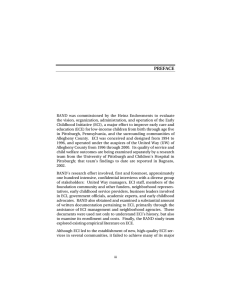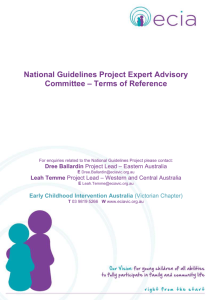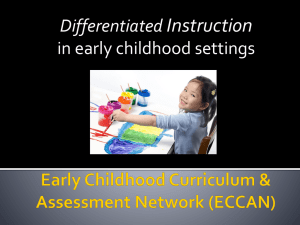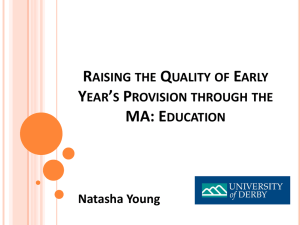JSIF Presentation - The Early Childhood Commission
advertisement
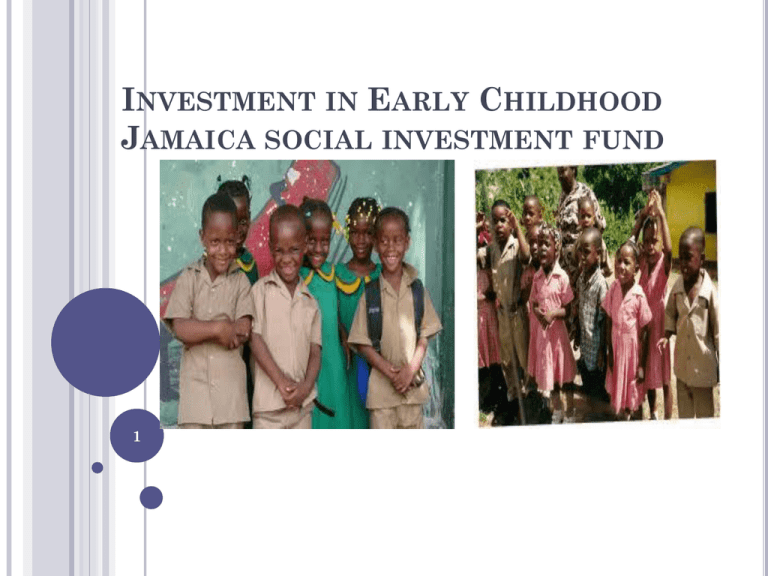
INVESTMENT IN EARLY CHILDHOOD JAMAICA SOCIAL INVESTMENT FUND 1 ABOUT THE JAMAICA SOCIAL INVESTMENT FUND (JSIF) Established in 1996 as a component of the Government of Jamaica’s (GoJ's) national poverty alleviation strategy. The Fund is designed primarily to channel resources to small-scaled community based projects across the island. Target – poor communities (pockets of poverty) Funders – GOJ, International Development Partners (World Bank, CDB, EU, PetroCaribe Development, Japanese Social Development Fund). 2 JUSTIFICATION FOR THE JSIF’S INVESTMENT IN ECI’S Investment in early childhood education supports and implements provisions stated by the Convention on the Rights of the Child (CRC). National Policy Framework – Education Sector Plan Vision 2030, National Strategic Plan (NSP) 2008-2013. Education is a human right, early childhood education is key to sustainable development. Research has shown that returns on investment in education are longterm and far-reaching. 3 CHALLENGES IN THE EC SECTOR 1. 2. 3. 4. 5. Insufficient access to quality facilities Unregistered early childhood facilities Inadequate number of trained teachers Inadequate facilities to accommodate children with special needs. Inadequate recreation spaces in ECIs 4 JSIF’S CONTRIBUTION TO THE EC SECTOR Investment in social infrastructure – construction and renovation of 212 ECIs with 14,018 direct beneficiaries Assist in the formation and training of 212 Maintenance Committees to manage and maintain each facility . Since its inception in 1996 up to 2012, JSIF has supported 254 projects in 212 basic, infant and primary schools. Delivery of Organisation Strengthening to PTA/School Boards etc 5 PROJECT ACTIVITIES • Construction of School building • Renovation/rehabilitation/ expansion of school building • Fencing • Hurricane repairs • Construction/renovation of play area • Furnishing – desk, chairs, kitchen equipment, water tanks, computers, fans etc. Formation and Training of Maintenance Committees • • Organisational Strengthening of PTA/School Boards 6 TYPES OF INSTITUTIONS Type of institution # of projects Percentage Basic Schools 216 85.1 Community Centres with a Basic School 1 0.4 Infant schools or Infant Departments in Other Schools 37 14.6 254 100 TOTAL 7 PARISH Profile of ECI facilities Assisted by JSIF by Parish 14% 12% 12% Clarendon 11% 10% 10% 10% Hanover 10% 9% 8% 6% 4% 2% 0% 9% Kingston Manchester Portland St. Andrew 6% 5% 5% 5% St. Ann St. Catherine 3% St. Elizabeth 3% 2% St. James St. Mary St. Thomas Trelawny Westmoreland 8 LEVEL OF INVESTMENT JSIF Investment in ECI (1996-2012) 212,730,179.00 (14%) Emergency Response 1,280,589,127 (86%) Other Types 9 JSIF’S COMPLIANCE WITH ECC STANDARDS The twelve standards that structure the Inspection Checklist are: 1. Staffing 2. Developmental/Educational Programmes 3. Interactions & Relationships with Children 4. Physical Environment 5. Indoor and Outdoor Equipment, Furnishing & Supplies 6. Health 7. Nutrition 8. Safety 9. Child Rights, Child Protection &Equality 10. Interactions with Parents & Community Members 11. Administration 12. Finance JSIF’s investment has primarily focused on: Standard # 4 - Physical Environment Standard 5 - Indoor and Outdoor Equipment, Furnishing & Supplies In addressing these 2 standards, the organization has indirectly impacted on standards relating to quality and the learning environment being provided to students to some extent. 10 PLANNED INVESTMENTS (2013-2014) 1. Ulster Spring Basic School - 2. Dutch Hill Basic School - 3. Clarence Brimm Basic School 4. Raymoth Notice Basic School 5. Albert Town Primary and Infant School 6. Savannah Basic School 7. St. Simon Basic School 8. St. Mary’s Early childhood Institution 11 IMPACT OF JSIF INVESTMENT: VIEWS OF BENEFICIARIES 1. 2. 71% of principals highlighted positive outcomes for children including greater level of comfort and happiness for students, cleaner more spacious and safe environment, better academic performance, greater level of focus, better health/nutrition, increased attendance and enrollment 86% of teachers stated that students that students are now more focused and as a result performing better academically Source: UWI SALISES (2013); Final Report ECI Consultancy 12 THE END 13


